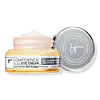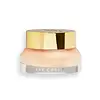What's inside
What's inside
 Key Ingredients
Key Ingredients

 Benefits
Benefits

 Concerns
Concerns

 Ingredients Side-by-side
Ingredients Side-by-side

Water
Skin ConditioningTheobroma Cacao Seed Butter
EmollientGlycerin
HumectantDimethicone
EmollientIsohexadecane
EmollientPropanediol
SolventGlyceryl Stearate
EmollientPEG-20 Stearate
EmulsifyingNiacinamide
SmoothingPEG/PPG/Polybutylene Glycol-8/5/3 Glycerin
HumectantHydroxyproline
Skin ConditioningHydrolyzed Soy Protein
HumectantStearic Acid
CleansingPEG-100 Stearate
Palmitic Acid
EmollientGlycine
BufferingOctyldodecanol
EmollientPolyacrylamide
Silica Silylate
EmollientButylene Glycol
HumectantPhenoxyethanol
PreservativeCaffeine
Skin ConditioningC13-14 Isoparaffin
EmollientPentylene Glycol
Skin ConditioningCI 77891
Cosmetic ColorantTocopherol
AntioxidantHydrolyzed Rice Protein
Skin ConditioningCaprylyl Glycol
EmollientCarbomer
Emulsion StabilisingMica
Cosmetic ColorantLaureth-7
EmulsifyingPanax Ginseng Root Extract
EmollientSodium Hyaluronate
HumectantProline
Skin ConditioningAlanine
MaskingCapryloyl Salicylic Acid
ExfoliatingTrisodium Ethylenediamine Disuccinate
Myristic Acid
CleansingPentaerythrityl Tetra-Di-T-Butyl Hydroxyhydrocinnamate
AntioxidantCeramide NP
Skin ConditioningAdenosine
Skin ConditioningSodium Lactate
BufferingHydroxypalmitoyl Sphinganine
Skin ConditioningPolysorbate 20
EmulsifyingSodium Hydroxide
BufferingCI 77491
Cosmetic ColorantTin Oxide
AbrasivePalmitoyl Tripeptide-1
Skin ConditioningPalmitoyl Tetrapeptide-7
Skin ConditioningWater, Theobroma Cacao Seed Butter, Glycerin, Dimethicone, Isohexadecane, Propanediol, Glyceryl Stearate, PEG-20 Stearate, Niacinamide, PEG/PPG/Polybutylene Glycol-8/5/3 Glycerin, Hydroxyproline, Hydrolyzed Soy Protein, Stearic Acid, PEG-100 Stearate, Palmitic Acid, Glycine, Octyldodecanol, Polyacrylamide, Silica Silylate, Butylene Glycol, Phenoxyethanol, Caffeine, C13-14 Isoparaffin, Pentylene Glycol, CI 77891, Tocopherol, Hydrolyzed Rice Protein, Caprylyl Glycol, Carbomer, Mica, Laureth-7, Panax Ginseng Root Extract, Sodium Hyaluronate, Proline, Alanine, Capryloyl Salicylic Acid, Trisodium Ethylenediamine Disuccinate, Myristic Acid, Pentaerythrityl Tetra-Di-T-Butyl Hydroxyhydrocinnamate, Ceramide NP, Adenosine, Sodium Lactate, Hydroxypalmitoyl Sphinganine, Polysorbate 20, Sodium Hydroxide, CI 77491, Tin Oxide, Palmitoyl Tripeptide-1, Palmitoyl Tetrapeptide-7
Water
Skin ConditioningHelianthus Annuus Seed Oil
EmollientCaprylic/Capric Triglyceride
MaskingPEG-7 Glyceryl Cocoate
EmulsifyingButylene Glycol
HumectantButyrospermum Parkii Butter
Skin ConditioningNiacinamide
SmoothingGlyceryl Stearate Se
EmulsifyingHydrogenated Jojoba Oil
AbrasiveIsopropyl Isostearate
EmollientSqualane
EmollientHydroxyethyl Acrylate/Sodium Acryloyldimethyl Taurate Copolymer
Emulsion StabilisingXanthan Gum
EmulsifyingLecithin
EmollientBenzyl Alcohol
PerfumingSodium PCA
HumectantPolysorbate 60
EmulsifyingDisodium EDTA
3-O-Ethyl Ascorbic Acid
Skin ConditioningDehydroacetic Acid
PreservativeTocopherol
AntioxidantSorbitan Isostearate
EmulsifyingSodium Benzoate
MaskingPotassium Sorbate
PreservativeCI 19140
Cosmetic ColorantCI 16035
Cosmetic ColorantWater, Helianthus Annuus Seed Oil, Caprylic/Capric Triglyceride, PEG-7 Glyceryl Cocoate, Butylene Glycol, Butyrospermum Parkii Butter, Niacinamide, Glyceryl Stearate Se, Hydrogenated Jojoba Oil, Isopropyl Isostearate, Squalane, Hydroxyethyl Acrylate/Sodium Acryloyldimethyl Taurate Copolymer, Xanthan Gum, Lecithin, Benzyl Alcohol, Sodium PCA, Polysorbate 60, Disodium EDTA, 3-O-Ethyl Ascorbic Acid, Dehydroacetic Acid, Tocopherol, Sorbitan Isostearate, Sodium Benzoate, Potassium Sorbate, CI 19140, CI 16035
 Reviews
Reviews

Ingredients Explained
These ingredients are found in both products.
Ingredients higher up in an ingredient list are typically present in a larger amount.
Butylene Glycol (or BG) is used within cosmetic products for a few different reasons:
Overall, Butylene Glycol is a safe and well-rounded ingredient that works well with other ingredients.
Though this ingredient works well with most skin types, some people with sensitive skin may experience a reaction such as allergic rashes, closed comedones, or itchiness.
Learn more about Butylene GlycolNiacinamide is a multitasking form of vitamin B3 that strengthens the skin barrier, reduces pores and dark spots, regulates oil, and improves signs of aging.
And the best part? It's gentle and well-tolerated by most skin types, including sensitive and reactive skin.
You might have heard of "niacin flush", or the reddening of skin that causes itchiness. Niacinamide has not been found to cause this.
In very rare cases, some individuals may not be able to tolerate niacinamide at all or experience an allergic reaction to it.
If you are experiencing flaking, irritation, and dryness with this ingredient, be sure to double check all your products as this ingredient can be found in all categories of skincare.
When incorporating niacinamide into your routine, look out for concentration amounts. Typically, 5% niacinamide provides benefits such as fading dark spots. However, if you have sensitive skin, it is better to begin with a smaller concentration.
When you apply niacinamide to your skin, your body converts it into nicotinamide adenine dinucleotide (NAD). NAD is an essential coenzyme that is already found in your cells as "fuel" and powers countless biological processes.
In your skin, NAD helps repair cell damage, produce new healthy cells, support collagen production, strengthen the skin barrier, and fight environmental stressors (like UV and pollution).
Our natural NAD levels start to decline with age, leading to slower skin repair, visible aging, and a weaker skin barrier. By providing your skin niacinamide, you're recharging your skin's NAD levels. This leads to stronger, healthier, and younger looking skin.
Another name for vitamin B3 is nicotinamide. This vitamin is water-soluble and our bodies don't store it. We obtain Vitamin B3 from either food or skincare. Meat, fish, wheat, yeast, and leafy greens contain vitamin B3.
The type of niacinamide used in skincare is synthetically created.
Learn more about NiacinamideTocopherol (also known as Vitamin E) is a common antioxidant used to help protect the skin from free-radicals and strengthen the skin barrier. It's also fat soluble - this means our skin is great at absorbing it.
Vitamin E also helps keep your natural skin lipids healthy. Your lipid skin barrier naturally consists of lipids, ceramides, and fatty acids. Vitamin E offers extra protection for your skin’s lipid barrier, keeping your skin healthy and nourished.
Another benefit is a bit of UV protection. Vitamin E helps reduce the damage caused by UVB rays. (It should not replace your sunscreen). Combining it with Vitamin C can decrease sunburned cells and hyperpigmentation after UV exposure.
You might have noticed Vitamin E + C often paired together. This is because it is great at stabilizing Vitamin C. Using the two together helps increase the effectiveness of both ingredients.
There are often claims that Vitamin E can reduce/prevent scarring, but these claims haven't been confirmed by scientific research.
Learn more about TocopherolWater. It's the most common cosmetic ingredient of all. You'll usually see it at the top of ingredient lists, meaning that it makes up the largest part of the product.
So why is it so popular? Water most often acts as a solvent - this means that it helps dissolve other ingredients into the formulation.
You'll also recognize water as that liquid we all need to stay alive. If you see this, drink a glass of water. Stay hydrated!
Learn more about Water